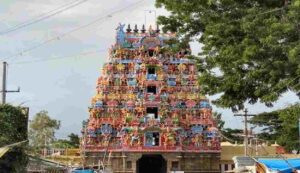Know about the interesting history and architecture of Apatsahayesvarar Temple located in Tamil Nadu
Apatsahayesvarar Temple: Alangudi village, in the Valangaiman taluk of Tiruvarur district, Tamil Nadu, India, is home to the Shiva temple known as Apatsahayesvarar Temple, also called Guru Sthalam. Lord Shiva, known as Apatsahayesvarar, is shown by the lingam. Ilavarkuzhali plays his consort, Parvati. The local tongue also refers to the temple as Tiru Irum Poolai.

The Tamil Saivite canonical work Tevaram, composed by Tamil saint poets known as the Nayanmars and categorized as a Paadal Petra Sthalam, extols the presiding god. Because it has temples to the Navagraha Sthalams, the ninth planetary element, and Guru (Jupiter), it is important to the Saivite branch of Hinduism.
The Apatsahayesvarar Temple’s backstory
Hindu mythology claims that the temple of Alangudi has a rich and ancient religious heritage. According to one myth, Lord Shiva ingested the venom of a snake named Vasuki while the gods and demons were scouring the seas for the nectar of immortality. It is stated that Vasuki’s poison would kill everyone who comes into contact with it, whether they are in heaven, hell, or on earth. Lord Shiva, known as “Apatasahyeswara” (meaning “savior” in Tamil), swallowed the poison himself in order to preserve the three realms. Because of this altruistic deed, the location was given the name Alangudi, which translates to “place of drinking poison.”
Apatsahayesvarar Temple’s History
Prior to the Nayak dynasty’s 16th-century additions, the complex’s original masonry building is said to have been constructed by the Cholas. The temple’s building was inspired by a mythical tale, according to the website of the temple authorities.
Legend has it that King Masukuntha Chakravarthi, who had previously assassinated his minister Amuthokar for refusing to sacrifice his morals for the king’s service, constructed the temple. However, the monarch was terrified when the minister was assassinated and his name was spoken across the nation. The monarch constructed the temple and fervently worshiped Lord Shiva as atonement for his transgressions.
The Apatsahayesvarar Temple’s architecture
Two prakarams, or enclosed complexes, and a five-tiered rajagopuram, or entrance tower, are features of the Apatsahayesvarar Temple in Alangudi. The two-acre temple complex is home to several temples, the most well-known of which are Apatsahayesvarar and Elavarkuzhali.
The temple’s two-tiered entrance towers, or gopurams, provide views of the Uttara and the Apatsahayesvarar Temple. Apatsahayesvarar is worshipped in the main temple, although Elavarkuzhali has its own shrine inside the compound. South Indian temple architecture is typified by the temple’s elaborately carved pillars, colorful paintings, and exquisite sculptures. In the center is the temple’s sanctum sanctorum, also known as the holy of holies. It is surrounded by smaller shrines to different deities.
Apatsahayesvarar Temple facts
- The god of this well-known Navagraha temple is the Guru, also known as Jupiter.
- It is said that Amuthokar, a devoted follower of Lord Shiva and the minister of a monarch by the name of Masukuntha Chakravarthi, constructed the Alangudi Apatsahayesvarar Temple.
- Apatasahayeswara, the temple’s principal deity, is an idol of a self-manifested linga.
- Lord Dakshinamurthy, who is revered as the embodiment of Jupiter, is worshiped here at the Alangudi Apatasahayeswara shrine with tremendous devotion since there isn’t a direct shrine for the planet Jupiter in this location.
- The Alangudi Apatsahayesvarar Temple is regarded as a “Pancha Aranya Sthalam,” or a location encircled by five woods.
- The Poolai Bush is the object of affection in the Alangudi Apatsahayeeshwara Temple and is regarded as its holy tree.
The Apatsahayesvarar Temple hosts renowned festivals
- The monthly festivities include Amavasai (new moon), Kiruthigai, Pournami (full moon day), and Sathurthi.
- Other festivals include Vinayaka Chaturthi, Aadi Pooram, Navarathri, Skanda Sashti, Karthikai Deepam, Arudra Darisanam, Thaipusam, Masi Magam, Panguni Uthiram, and Vaikasi Vishakam.
- Brahmotsavam is an important event that is observed during the Tamil month of Chittirai (April–June). Special worship rituals are followed at this time, and the deity’s festival picture is paraded through Alangudi’s streets.
How do I go to the Temple of Apatsahayesvarar?
The temple is situated in the Tamil Nadu hamlet of Alangudi, which is in the Valangaiman taluk of the Tiruvarur district.
- By Air: The temple is 98 kilometers from Trichy Airport. The distance between the temple and Pondicherry Airport is 151 kilometers.
- By Rail: The temple is located 7 km from Needamangalam and 16 km from Kumbakonam.
- By Road: Alangudi, close to Kumbakonam, is home to the Apatsahayeshwara Temple. There is regular bus service to get here. The distance between the temple and Kumbakonam Bus Terminal is 18 kilometers.

